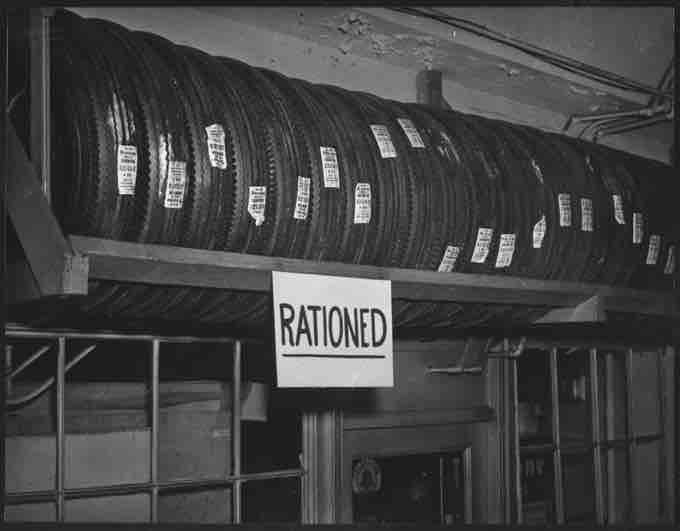ECONOMIC CONTROL DURING THE WAR
Following the New Deal practice, the Roosevelt Administration established a number of new government agencies or expanded the role of those launched under the New Deal in order to convert the peacetime economy to the requirements imposed by the war effort. Three of them, the Office of Price Administration (OPA; est. 1941), the Office of Administrator of Export Control (est. 1940; its functions later transferred to the Economic Defense Board and in 1943 to the Office of Economic Warfare) and the War Production Board (WPB; est. 1943) were among the federal agencies in charge of controlling the economy so that the United States was able to meet the demands of World War II.
OFFICE OF PRICE ADMINISTRATION
Executive Order 8875 established the Office of Price Administration (OPA) in 1941. The functions of the OPA were originally to control money (price controls) and rents after the outbreak of World War II. It became an independent agency under the Emergency Price Control Act 1942. The OPA had the power to place ceilings on all prices except agricultural commodities, and to ration scarce supplies of other items, including tires, automobiles, shoes, nylon, sugar, gasoline, fuel oil, coffee, meats, and processed foods. At the peak, almost 90% of retail food prices were frozen. The OPA could also authorize subsidies for production of some of those commodities and controlled wages. Most functions of the OPA were transferred to the newly established Office of Temporary Controls (OTC) by Executive Order 9809, December 12, 1946. The Financial Reporting Division was transferred to the Federal Trade Commission.

Rationed tires, ca. 1942-1946
The rationing of goods became common during World War II.
WAR PRODUCTION BOARD
The War Production Board (WPB) was established as a government agency on January 16, 1942 by executive order of Franklin D. Roosevelt, replacing the Supply Priorities and Allocation Board and the Office of Production Management. The WPB directed conversion and expansion of peacetime industries to meet war needs, allocated scarce materials vital to war production, established priorities in the distribution of materials and services, and prohibited non-essential production. It rationed such commodities as gasoline, heating oil, metals, rubber, paper, and plastics.
The WPB and the nation's factories effected a great turnaround. Military aircraft production, which totaled 6,000 in 1940, jumped to 85,000 in 1943. Factories that made silk ribbons now produced parachutes, automobile factories built tanks, typewriter companies made machine guns, undergarment manufacturers sewed mosquito netting, and a roller coaster manufacturer converted to the production of bomber repair platforms. The WPB ensured that each factory received materials it needed to operate, in order to produce the most war goods in the shortest time. In 1942-45, WPB supervised the production of $183 billion worth of weapons and supplies, about 40% of the world output of munitions. Britain, the USSR and other allies produced an addition 30%, while the Axis produced only 30%. One fourth of the US output was warplanes; one fourth was warships. Meanwhile, the civilian standard of living was about level.
EXPORT CONTROL
In July 1940, the Export Control Act was passed as a measure employed to avoid scarcity of critical commodities in a likely pre-war environment and to limit the export of materials to Imperial Japan. The act originated as a presidential proclamation forbidding the exporting of aircraft parts, chemicals, and minerals without a license, and was intended to induce Japan to curtail its occupation of the Indo-Chinese coast. The same year, the Office of Administrator of Export Control was established to administer the provisions of the act. Only a year later, its functions were transferred to the Economic Defense Board (later changed to the Board of Economic Warfare). The Board, chaired by Vice President Henry Wallace, aimed to strengthen economic international relations (through the control of imports and exports) and supported the Allied war effort through procurement of strategic resources (including arms). After a set of controversies over the Board's authority and financing, its functions were transferred to the newly created Office of Economic Warfare in the Office for Emergency Management in 1943.